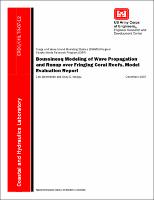Please use this identifier to cite or link to this item:
https://hdl.handle.net/11681/7701| Title: | Boussinesq modeling of wave propagation and runup over fringing coral reefs, model evaluation report |
| Authors: | Demirbilek, Zeki Nwogu, Okey G. |
| Keywords: | Bottom friction Boussinesq wave model Directional wave spectrum Low-frequency oscillations Spilling and plunging breaking waves Turbulence, Smargorinsky dissipation Wave propagation Wave runup Wave setup Coastal Inlets Research Program (U.S.) Surge and Wave Island Modeling Studies Program (U.S.) |
| Publisher: | Engineer Research and Development Center (U.S.) |
| Series/Report no.: | Technical report (Engineer Research and Development Center (U.S.)) ; no.ERDC/CHL TR-07-12 |
| Abstract: | This report describes evaluation of a two-dimensional Boussinesq-type wave model, BOUSS-2D, with data obtained from two laboratory experiments and two field studies at the islands of Guam and Hawaii, for waves propagating over fringing reefs. The model evaluation had two goals: (a) investigate differences between laboratory and field characteristics of wave transformation processes over reefs, and (b) assess overall predictive capabilities of the model for reef systems with steep slopes and extended widths in shallower water. The focus in this evaluation study was on wave breaking, bottom friction parameterization, and wave setup and runup capabilities of Boussinesq wave model. In this report, the testing procedure and performance of the Boussinesq wave model are discussed. Because details of the laboratory and field studies were unavailable at the time of writing, and these are expected to be documented in other reports, only some general features of data pertinent to the numerical modeling study are presented. The time series of laboratory and field data were used in the numerical model validation study. These were converted to wave energy spectral densities, significant wave height, peak wave period, and mean water level setup for comparison to model predictions. Findings from comparisons of measurements and model calculations are presented in figures and tables, and these are supplemented as necessary with discussion of the model’s capability in describing different wave processes over coral reefs. Overall, the model performed reasonably well for laboratory data with errors of less than 10 percent for the maximum runup height. For the field data, it was determined that wave energy dissipation over extremely rough coral reef surfaces could not be simply described by a quadratic bottom friction law. Reasonable model-data agreement was obtained by using an eddy-viscosity type term to parameterize wave energy dissipation due to the turbulent boundary layer over rough coral reef bottoms. |
| Description: | Technical Report |
| Gov't Doc #: | ERDC/CHL TR-07-12 |
| Rights: | Approved for public release; distribution is unlimited |
| URI: | http://hdl.handle.net/11681/7701 |
| Appears in Collections: | Technical Report Technical Report |
Files in This Item:
| File | Description | Size | Format | |
|---|---|---|---|---|
| CHL-TR-07-12.pdf | ERDC/CHL TR-07-12 | 2.91 MB | Adobe PDF |  View/Open |